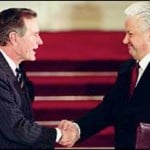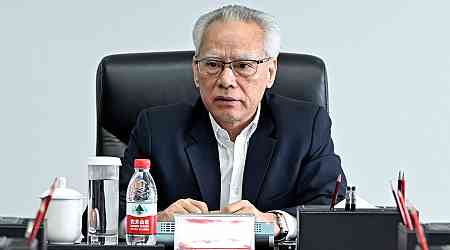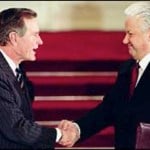The United States of America and the Russian Federation have agreed to cut the number of nuclear warheads they have by between 3,000 and 3,500.
US President George Bush, who leaves office this month, and his Russian counterpart Boris Yeltsin, signed the second Strategic Arms Reduction Treaty – Start II – in Moscow.
Currently each side has about 10,000 warheads and Start II marks the biggest reduction ever agreed.
In addition, sea-based weapons will be cut to 1,750 each and all land-based multiple-warhead missiles will be eliminated.
Mr Bush said the treaty offers “for parents and children, a future free from fear”, and Mr Yeltsin called it “a treaty of hope”.
The treaty means that by 2003, three-quarters of the nuclear warheads possessed by both countries at the start of the 1990s will have been destroyed.
Mr Yeltsin believes Start II shows that Russia has abandoned the arms race.
“I think it important for Russia’s might as a great power to be determined not by the quantity of missiles but by the living standards of its citizens, the development of culture, education and national traditions,” he said.
Mr Yeltsin admitted the treaty will meet opposition before it is ratified in the Russian parliament.
The US Congress also has to agree to Start II, as well as the parliaments of the former Soviet republics of Byelorussia, Ukraine and Kazakhstan where nuclear weapons are still held.
Mr Yeltsin has been criticised for making too many concessions to the US, by relinquishing all of Russia’s land-based SS-18 missiles with multiple warheads – the core of its strike capability.
By contrast the US appears to have kept a tactical advantage by agreeing to halve its submarine-based warheads, which form the heart of its nuclear arsenal.
Courtesy BBC News
In context
By 2001, the two countries had met the criteria set out in Start I.
Start II was ratified by the US Congress in 1996 and Byelorussia, Ukraine and Kazakhstan transferred warheads in their territory to Russia and destroyed the accompanying delivery vehicles.
In 1997, US President Bill Clinton and Russian President Boris Yeltsin had to extend the treaty’s deadline to 2007 and set out to begin negotiations on a Start III treaty for further reductions.
The Russian parliament eventually agreed to Start II in 2000, but it, and Start III, were abandoned.
Instead, in 2002, US President George W Bush and Russian President Vladimir Putin signed the Strategic Offensive Reductions Treaty – better known as the Treaty of Moscow.
By 2012, the treaty aims to cut the nuclear warheads of each side from levels of between 6,000 and 7,000, to between 1,700 and 2,200 each.
But measures outlined in Start II to destroy the methods of delivering nuclear weapons – such as bombers, submarines and launchers – were not addressed in the Moscow Treaty.

































